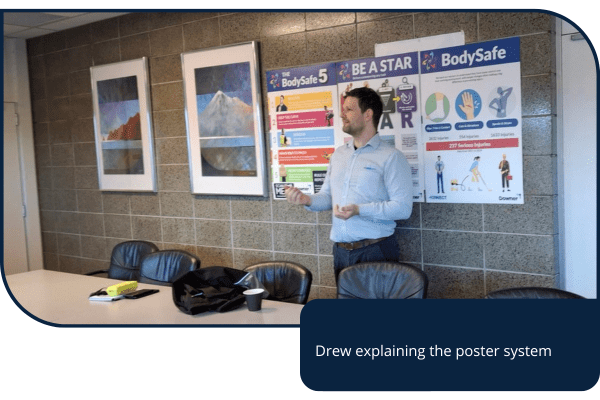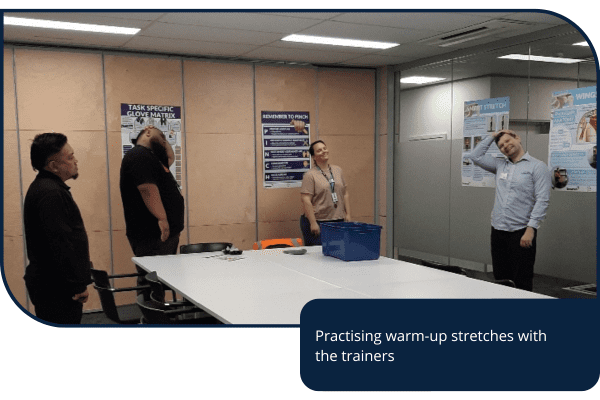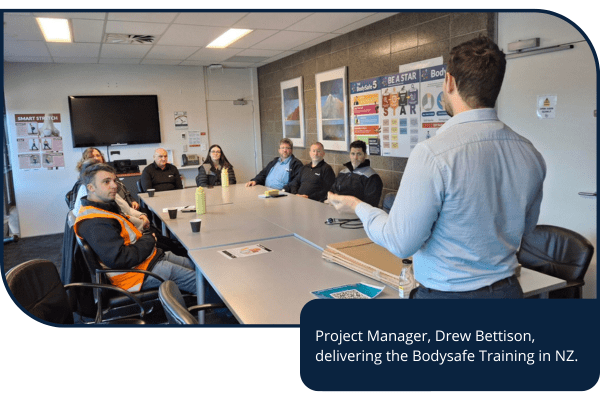Drew takes PowerPoint-free manual handling training to New Zealand
Manual handling training isn’t a program that workers are usually excited to attend, despite being a tool to empower them to prevent injuries. The content may be listened to and noted, but often doesn’t translate into meaningful behavioural change. Armed with this knowledge and a challenge to deliver manual handling training to thousands of workers, Downer approached KINNECT to create an engaging, scalable program – and the results have been impressive.
Project Manager, Drew Bettison who went on a two-week trip rolling out the program in New Zealand this winter, after running it successfully in Australia, took us through the process.
Back to the future – from PowerPoint to Posters
“Downer wanted a more practical, innovative manual handling program and came to us to create something that they could deliver to their workforce at scale in Australia and New Zealand. We usually conduct training in groups of 20-25, but with such a large workforce it’s more efficient and affordable for them to train their staff to deliver the program in-house,” Drew said.
Instead of a PowerPoint presentation that’s more likely to elicit sleep than engagement, KINNECT and Downer collaborated to devise a streamlined Train-the-Trainer style session consisting of five ‘stations’ around the room, with each station having two posters. The KINNECT consultant explains what’s required at each station, demonstrates correct manual handling technique, and then asks each participant to take turns delivering the content back to the group to demonstrate their understanding.
“It’s delivered as a single very practical, face-to-face session with four to five participants so there’s lots of opportunities for interaction and questions,” he explained. Each station focuses on a key aspect of manual handling; 1) Statistics and the reason for running the program, 2) Lower backs, 3) Shoulders, 4) Hand Safety and 5) Knees.
“The participants use the same posters when they’re training their colleagues. We’ve added a QR code to the posters so if they forget something, they can use their phone to bring up notes and even a script to explain things”.
The 5-station workshop method is heavily embedded within Downer and has become quite central to their training approach.

“KINNECT consultants are Accredited Exercise Physiologists, Occupational Therapists and Physiotherapists, but we don’t expect these new trainers to deliver the content of each station the same way that we do. We go into more details of the musculoskeletal system and the anatomy of manual handling, for example the mechanisms of how a disk can bulge.
“Downer’s in-house trainers don’t need to fully understand how the musculoskeletal system works. They just need to explain the take home message of what causes the disc to bulge and show the workers how to keep their spine in a neutral position, or why they should avoid twisting their knees. Then they can ensure the workers actually put that into practice.”
Content that resonates with real-world examples
The program combines elements of KINNECTs existing manual handling, HandSafe and SmartStretch programs. The first station, however, presents injury statistics from Downer to impress on participants how likely an injury is, and therefore how important the training is. “It’s impactful, and helps the trainers understand the necessity for the training. However, their favourite is the second station which is all about lower back injuries.”
Drew explained that they intentionally use equipment in the training that the participants are using in the day-to-day jobs like landscaping or cleaning equipment. “For example, cleaners make up a large cohort of their staff where injuries often come from using backpack vacuum cleaners. We showed them how to put the vacuum cleaner on and take it off safely in the session,” he said.
Expanding the program from Australia to New Zealand
Drew and a team of consultants rolled out the program to Downer employees Australia wide, training workers in Perth, Adelaide, Melbourne, Sydney and multiple locations in Queensland. Based on a positive response to those sessions, KINNECT was asked to visit six sites in New Zealand in July this year.
Before braving the freezing winter weather, Drew collaborated with the client and employees in each location to schedule the sessions and communicate what the program involved. The number of sessions at each site varied, from four sessions one day, to a single session the next day, depending on the number of employees at each site, the aim being to train as many people as possible in a short timeframe.
He then began his packed schedule in the North Island:
“I flew into Auckland for two days of sessions there before heading to Napier on the east coast and then one day in Wellington.
“A perk of travelling to deliver projects for KINNECT is being able to see new places – on this trip I got to spend the weekend in Wellington. I’m a bit of a Lord of the Rings fan so I visited the museum and a few filming locations, plus a few bars and some good restaurants.
“I then drove down to Ohakea. After some great sessions there I made a quick drive to the airport to make a flight to Christchurch. After sessions there, I made my final stop in Dunedin in the south before heading to up to Queenstown for some time off,” Drew recalled.
With innovation comes impressive results
Feedback so far has shown the program to be a tremendous success with sessions in New Zealand receiving a 100+ Net Promoter Score (NPS) from participants. “Some people told me it was the best manual handling training they’d been to, and Rachel, Adrian, Rhys, Kerry and Ben received very positive feedback when they delivered the program in Australia.”
While Drew is interested to see how the program translates into reducing injuries down the line, it’s clear that the train-the-trainer model is effective in reaching workers at a larger scale than was previously possible. KINNECT has now trained 269 trainers who have since already delivered 1261 sessions themselves to 9053 staff.
Downer is thrilled with program’s success, having garnered an 87% satisfaction rate from their feedback forums.
Drew believes that the program works because of its highly practical approach that prioritises doing over listening:
“It’s one thing to hear ‘keep your back straight’ – it’s another to physically demonstrate and practice it yourself. I get them to demonstrate a technique and once they can do it themselves and explain it to me correctly, then I know that they can explain it to their staff and train them properly.
“A happy side effect is that we’re also creating a team of ‘on-the-job’ manual handling coaches who have the skills to identify if a colleague is using incorrect techniques that may cause an injury, simply because of all the practice they’ve had themselves,” Drew said.
Refining the program for the future
Delivering the program so frequently has given Drew his own professional development opportunity by allowing him to refine his presenting style:
“In the sessions I had a lot of laughs with the staff, and it improved my own delivery of the program. I’m still learning myself how to best to train people and get them engaged and on board with the subject.
“After about 20 sessions in New Zealand I started to get quite efficient at delivering the training. Hopefully next year we’ll be able to do an even better job at getting people to learn and teach their own people to be healthier, happier and safer at work, which is what we’re all about here,” Drew reflected.
The collaborative process that shaped the last 12 months will continue with Downer as Drew and his team continue refining the program and strengthening the partnership.
If you’re interested in taking a different approach to occupational health through manual handling training and injury prevention programs, please get in touch with our project team.